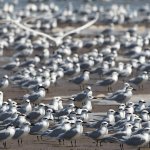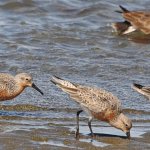By Natalia Martínez Curci and Juan G. Navedo
Translated to English by WHSRN Executive Office
The Chiloé Archipelago in southern Chile is one of the most important sites for shorebirds in the Pacific Flyway of the Americas. It is home to several species of conservation priority, including some of the largest non-breeding concentrations of Nearctic migrants such as the Hudsonian Godwit (Limosa haemastica) and the Whimbrel (Numenius phaeopus). Approximately 99% and 30% of the Pacific populations, respectively, spend the austral summer in Chiloé, as well as a small population of the endangered Red Knot (Calidris canutus). In addition to hosting tens of thousands of shorebirds and other aquatic birds every year, Chiloé’s eastern coasts offer excellent conditions for the development of aquaculture and tourism activities, which are the economic livelihood of many local communities. This makes an excellent scenario for studying the effect of anthropogenic activity on birds and their habitats, and to identify opportunities to make the ecological requirements of birds compatible with the socio-economic needs of local communities.
Since 2014 by the Bird Ecology Laboratory (BEL) of the Instituto de Investigaciones Marinas y Costeras (Institute of Marine and Limnological Sciences) of the Universidad Austral de Chile, in collaboration with the local NGO CECPAN, have focused research in this area on in several coastal wetlands of Chiloé, some of them belonging to the site of Hemispheric Importance “Humedales orientales de Chiloé” of the Western Hemisphere Shorebird Reserve Network (WHSRN).
The research tasks developed by the BEL are long-term ecological studies, mainly carried out by undergraduate and graduate students, postdoctoral researchers, and natural science professionals such as biologists, veterinarians, and natural resource conservation engineers. One project conducted assessments of benthic invertebrate communities to know the food available to shorebirds and its inter-annual variations (1). Another project studied shorebird populations through scientific banding, marking individuals with remote reading flags, taking biological samples and the use of technology like geolocation and remote tracking systems, with the aim of studying the ecology and movements of birds at different scales. These studies allow general evaluations of shorebird populations, and in particular the state of preparedness of individuals for migration (2), at sites with different degrees of development of anthropogenic activities, with special emphasis on salmon farming, seaweed cultivation, and the presence of people in intertidal zones.


Left: Flock of Hudsonian Godwits at Humedales orientales de Chiloé. Photo: Natalia Martínez Curci. Right: Monitoring shorebirds during algae harvest. Photo: Federico Barbano.
Starting in 2019 and with the support of the Coastal Solutions Fellows Program of the Lab of Ornithology at Cornell University, work began with the goal of integrating ecological and socioeconomic knowledge that would reduce the impact of algae farming on shorebirds. Within the aquaculture industry, extensive seaweed aquaculture has shown one of the highest growth rates in the last 10 years in marine and coastal areas globally. Given that this industry does not use fertilizers or pesticides and the most common algae farming systems do not permanently modify the environment, the activity is considered to have a low impact on ecosystems in comparison to others that require supplementary feed and or synthetic inputs such as salmon farming in Chiloé. Salmon farming uses enormous quantities of antibiotics, whose imprint is observed in the microbiota of birds (3). In turn, since the available scientific evidence suggests that algal settlements increase the multifunctionality of the ecosystem, i.e. its ability to provide multiple ecosystem services, it is expected that extensive algal aquaculture will continue to grow and expand globally.
Despite the above, it is important to consider that algae are ecosystem engineers, organisms that exert significant control over the availability of resources for other biota by changing the physical and chemical state of the environment. Therefore, if algal cultures are installed in intertidal zones previously devoid of vegetation, they produce changes that can significantly alter coastal habitats, creating more complex intertidal environments. BEL research has shown that on an experimental scale, algal cultures generate changes in benthic invertebrate communities that influence the foraging ecology of shorebirds (4). Therefore, it has been suggested that the establishment of these crops in key sites for shorebirds should be planned to ensure environmental heterogeneity at the landscape scale to ensure the persistence of uncultivated areas.

Harvest of algae. Photo: Natalia Martínez Curci.
In addition to the effects of cultivation, the harvesting of algae requires numerous people working in the intertidal during low tide, coinciding spatially and temporally with the daily feeding activities of shorebirds. In this regard, BEL work has shown that shorebird density decreases with increasing numbers of people and dogs in the intertidal area. At sites with higher numbers of people in the intertidal areas, birds lose a significant percentage of feeding time per low tide period. Therefore, it is recommended to avoid the presence of dogs in seaweed farms and keep the number of people working in the intertidal below the threshold density at which birds lose daily feeding time (5).
Using the recommendations from the ecological research conducted by BEL, along with local and indigenous knowledge, an interdisciplinary team was assembled to reach agreements on seaweed production compatible with shorebird conservation for implementation at a pilot site in Chiloé. Social science professionals played a key role in this team, in addition to contributing to reaching the desired agreements, they facilitated the process to create a guide of seaweed production practices compatible with shorebird conservation based on scientific, local, and indigenous knowledge. The site chosen for this pilot was Caulín Bay, where large abundances of shorebirds congregate annually, especially Hudsonian Godwits, and where much of the community derives its economic livelihood from the cultivation of a red algae locally known as Pelillo (Gracilaria chilensis). Caulín Bay has recently been declared an Indigenous Peoples’ Marine Coastal Space (Espacio Costero Marino de Pueblos Originarios – ECMPO in Spanish), in accordance with the Lafkenche Law (No. 20,249), which grants the administration and exploitation rights of delimited coastal-marine spaces to indigenous communities, which in turn have the obligation to ensure their conservation.


Left: Algae farm. Photo: Natalia Martínez Curci. Right: Monitoring shorebirds during algae harvest. Photo: Federico Barbano.
The guide establishes recommendations to minimize the effect of the activity on shorebirds to be implemented both before and during planting, as well as during harvesting, gathering, and drying of the algae. Some of these recommendations favor the development of other community interests, such as the development of ornithological tourism and traditional shellfishing, which are in line with the ECMPO Management Plan and help fulfill its objectives.
We hope that the work done with the Bahía Caulín ECMPO community and other local stakeholders, as well as the agreements reached, will be a model to be scaled up to other sites of importance for shorebird conservation with similar characteristics in southern Chile. Our pilot case suggests that the management of coastal areas by native peoples can favor shorebird conservation by implementing actions that improve the habitat conditions on which they depend. Therefore, working with these self-organized communities in southern Chile offers an excellent opportunity to achieve effective shorebird conservation at a local and, because of the relevance of Chiloé, hemispheric scale.
Bibliography:
- Micael JF, Navedo JG. 2018. Macrobenthic communities at high southern latitudes: food supply for long-distance migratory shorebirds. Austral Ecology 43: 955-964.
- Gutiérrez JS, Sabat P, Castañeda LE, Contreras C, Navarrete L, Peña-Villalobos I, Navedo JG. 2019. Oxidative status and metabolic profile in a long-lived bird preparing for extreme endurance migration. Scientific Reports 9: 17616.
- Navedo JG, Araya V, Verdugo C. 2021. Upraising a silent pollution: Antibiotic resistance at coastal environments and transference to long-distance migratory shorebirds. Science of the Total Environment 777: 146004.
- Martínez-Curci NS, Fierro P, Navedo JG. 2023. Does experimental seaweed cultivation affect benthic communities and shorebirds? Applications for extensive aquaculture. Ecological Applications: e2799.
- Navedo JG, Verdugo C, Rodríguez-Jorquera IA, Abad-Gómez JM, Suazo CG, Castañeda LE, Araya V, Ruiz J, Gutierrez JS. 2019. Assessing the effects of human activities on the foraging opportunities of migratory shorebirds in Austral high-latitude birds. Plos One 14: e0212441.
Natalia S. Martínez Curci, Researcher Instituto de Investigaciones Marinas y Costeras (IIMyC), CONICET -UNMdP, Argentina; Senior Fellow Coastal Solutions Fellows Program | Cornell Lab of Ornithology, USA & Associated Researcher Bird Ecology Lab | Universidad Austral de Chile, Chile. nmartinezcurci@conicet.gov.ar
Juan G. Navedo, Bird Ecology Lab, Instituto de Ciencias Marinas y Limnológicas, Universidad Austral de Chile & Instituto Milenio Biodiversidad de Ecosistemas Antárticos y Subantárticos (BASE). jgnavedo@uach.cl
Cover Photo: Harvest of algae. Photo: Natalia Martínez Curci.






